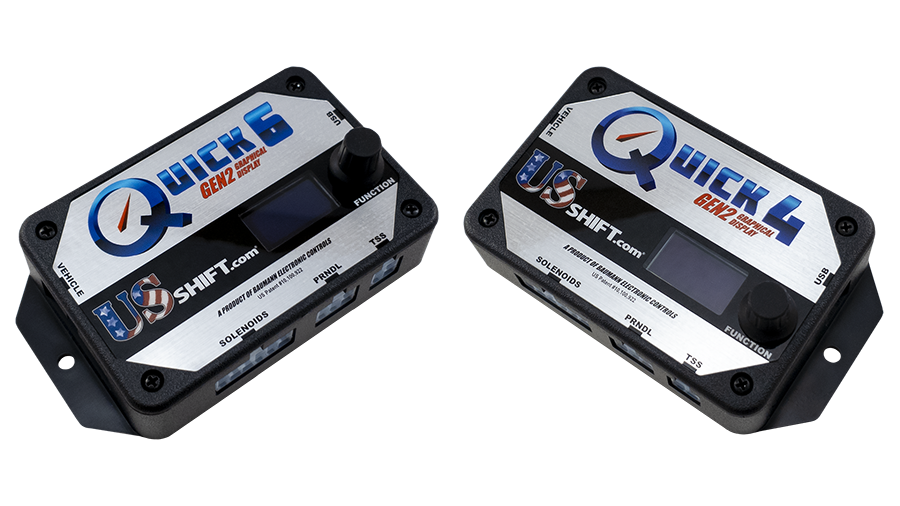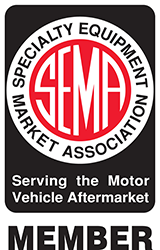
Frequently Asked Questions
Contents:
Initial Purchase
Q: Why would I need a stand alone transmission controller?
A: If you wish to retain the electronic overdrive transmission in your vehicle after bypassing or eliminating the factory ECU, or if you would like to install a newer transmission into an older vehicle to benefit from overdrive and increased power handling capability, you will likely need one of our systems.
Other popular modifications, upgrades, and repairs that benefit from US Shift controllers are:
- Engine swaps
- Aftermarket EFI system installations
- Converting to a carburetor
- Old or failing OEM electronics and wiring harnesses
- Vehicle restorations and upgrades
Also, the benefits of having complete tuning control over shift points, shift firmness, and torque converter clutch lock up alone are worth purchasing and installing one of our systems.
Q: Why should I choose US Shift as opposed to another company's product?
A: We've been developing and manufacturing stand alone transmission controllers since 1997. It is our primary focus, and our goal is to always provide the highest quality product and customer service. Each unit has a 10 year warranty, which is the best in the industry. And each controller contains proven performance and exclusive features that are only available from US Shift.
Q: Is your transmission control system compatible with an aftermarket EFI system?
A: Yes. Because our transmission control systems are completely stand alone, they can function with any aftermarket EFI system, diesel, or carburetor application.
Q: What is included with your system?
A: Each of our transmission control systems are packaged with the control module, complete wiring harness designed specifically for your transmission, installation manual, tuning software disc, and usb cable.
Q: How difficult are your systems to install?
A: Our systems are designed with ease of installation in mind and require basic automotive wiring skills and few (if any) tools. Depending on your application, install time could be anywhere from 2 to 4 hours. The installation manual provides step-by-step instructions including wiring diagrams. The majority of required connections are direct plug in and minimal soldering is required.
If your vehicle has a tight or narrow passageway, we offer a pin removal tool so that our wiring harness can be more easily fed through small spaces.
Q: What connections are required?
A: For our transmission controller to function properly, the only required connections are 12 volts switched power, ground, throttle position signal, and a vehicle speed signal. There are several optional connections you can choose from and each of these are explained in our installation manual.
Q: My vehicle has a carburetor, will your system work?
A: Yes. We offer multiple throttle position adapter kits for popular carburetors. These adapters can often be lightly fabricated to work if your particular carburetor is not one of the styles we offer. In any application, our controllers require a 0 to 5 volt TPS signal.
Q: Where do I mount the controller?
A: Any location you choose within the passenger compartment is acceptable. The module is not rated for under hood conditions. We recommend choosing a location that provides access to the built in USB port and, if possible, where the internal display can be viewed.
Q: Is a tachometer signal required? If so, how is it connected?
A: For all Quick 6 controllers, a tachometer signal is required. The Quick 4 will function without it, but we recommend connecting a tach signal in order to take full advantage of the Quick 4's capabilities.
The tachometer output from an MSD or similar ignition system is the best source. Coil negative is another source. Some engines that do not produce a typical tachometer signal from the factory (such as some diesel engines) may require an adapter or aftermarket signal generator.
Regardless of your tach signal source, our tuning software allows you to select from multiple signal options including a custom mode.
Q: Will my speedometer continue to work when using your transmission controller?
A: There is a dedicated speedometer output provided in our wiring harness that is designed to drive any electronic speedometer. If you are retaining an older cable-driven speedometer, there are aftermarket components that can be used to drive the cable and still provide the required vehicle speed signal to our controller.
Q: I want to update my older vehicle by installing a more modern, electronic overdrive transmission. How can I keep my original cable-operated speedometer operational?
A: There are several options for this depending on your transmission model. Aftermarket cable drive "boxes" available from companies such as Abbott and Dakota Digital work with most applications. For GM 4L80E, a tail housing conversion kit that includes a speedometer cable drive and the electronic OSS output are also available. Some early Ford E4OD units contained a cable speedometer drive located in the extension housing and also provide an electronic OSS signal.
Tuning & Software
Q: Do I need a laptop to operate your controller?
A: Basic adjustments you may choose to make (shift points, firmness, TCC engagement) can be done by using the built-in control knob. While not required, a Windows based PC or laptop running our Shiftware tuning software will provide access to the full range of features and diagnostics available.
Q: What tuning adjustments are your controllers capable of making?
A: Virtually every aspect of your transmission's operation is adjustable using our controller. Shift timing, feel, torque converter lock up, and line pressure are all capable of being independently controlled.
Q: Can I have more than one calibration? How do I switch between them?
A: Yes. Both Quick 4 and Quick 6 are capable of up to four separate calibrations being stored in them at any given time. Our wiring harnesses provide the option of installing a switch to toggle between these calibrations on the fly. You can also use the built-in control knob if you choose. Many customers will load a “street” or mild shift calibration, then have a firmer, more aggressive calibration available to select. This is very useful for towing, off road, or racing applications.
Q: Can I adjust my calibration and write it to the controller with the vehicle running?
A: Yes. However, please use caution if you choose to do this while driving. The changes you make will take effect immediately, even if the vehicle is moving.
Q: If I have difficulty achieving the calibration or shift behavior that I want, what support is available?
A: One major advantage of US Shift transmission controllers is their ability to record a data log while driving. Also, our extensive online Troubleshooting Guide and telephone Technical Support are available to you. Between these options, there is no issue related to your transmission's electronics we can't solve effectively.
Q: Do you offer any “ready to use” tunes or calibrations?
A: Our Shiftware tuning software does include several default calibrations for each transmission we support and many customers do not require any additional changes. Each application has different variables (i.e. speed sensor type, rear axle ratio, and tire height) that you should verify in the calibration prior to operating the vehicle. Our system is designed with individual customization in mind and adjustments are easily made. If you require any assistance, we are always available to help.
Q: If I have to disconnect my vehicle's battery, will the calibration in my controller be lost?
A: No. US Shift controllers are designed using flash memory and will not lose any information due to power loss.
Diesels
Q: I have a 7.3L Ford mechanical diesel engine. How do I provide a tachometer signal to your transmission controller?
A: The 7.3 mechanical diesel has a tachometer (rpm) sensor in the front cover of the injector pump. It is a 2 wire VR (variable reluctance) sensor and will need to connect to our yellow signal wire. Most read 106 gear teeth (cam speed) so the "pulses per crank rev" to enter into the calibration file under "custom" mode would be 53. It will also be necessary to remove a jumper inside the controller since the sensor is variable reluctance. This jumper info is in the jumper settings document on our website under publications.
Q: I have a 7.3L Powerstroke diesel engine. How do I provide a Throttle Position Signal to your transmission controller?
A: If it's a Powerstroke (electronic) 7.3, you will connect to the APP sensor signal wire that has a positive slope (voltage starts low and goes up as the throttle is increased). If there is more than 1 signal wire, you will need to choose the one with the widest voltage range from closed throttle to full throttle. Typically, it is Pin 89 Gray/White wire.
Q: I have an older (non turbo) GM 6.5L diesel. How do I provide a Throttle Position Signal to your transmission controller?
A: An original type replacement TPS for a '92-'93 6.5 mechanical diesel / 4L80E pickup. The GM part number is 0137417.
Q: I am swapping to a Dodge Cummins 12V. How do I provide a Throttle Position Sensor signal to your controller?
A: There are aftermarket pigtail adapters that plug into your existing TPS. An example would be part# 1378 available at Diesel Conversion Specialists.













